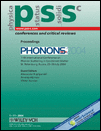Phonon effects in resonant “forbidden” reflections
Abstract
The influence of atomic vibrations on the ”forbidden” Bragg reflections, excited near absorption edges owing to anisotropic resonant X-ray scattering, is discussed. It is shown that in spite of the difference of X-rays and phonons energies the “forbidden” reflections can be extremely sensitive to the atomic vibrations and their correlations. The numerical calculations are performed taking into account the correlations of atomic thermal displacements, which give an adequate description of the thermal growth of the 600 forbidden reflection in Ge and describe drastic changes of the “forbidden” reflections spectra in ZnO. (© 2004 WILEY-VCH Verlag GmbH & Co. KGaA, Weinheim)




